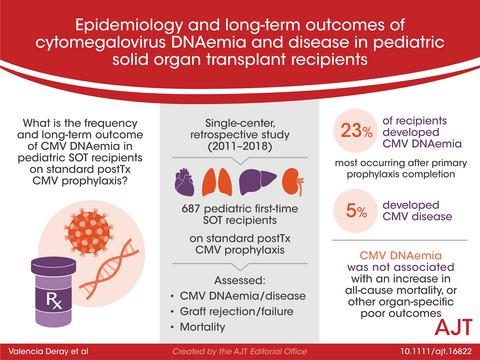当前位置:
X-MOL 学术
›
Am. J. Transplant.
›
论文详情
Our official English website, www.x-mol.net, welcomes your
feedback! (Note: you will need to create a separate account there.)
Epidemiology and long-term outcomes of cytomegalovirus DNAemia and disease in pediatric solid organ transplant recipients
American Journal of Transplantation ( IF 8.9 ) Pub Date : 2021-09-01 , DOI: 10.1111/ajt.16822 Kristen G Valencia Deray 1 , Kathleen E Hosek 2 , Divya Chilukuri 3 , Jordan R Dunson 3 , David R Spielberg 4 , Sarah J Swartz 5 , Joseph A Spinner 6 , Daniel H Leung 7 , Elizabeth A Moulton 1 , Flor M Munoz 1 , Gail J Demmler-Harrison 1 , Claire E Bocchini 1
American Journal of Transplantation ( IF 8.9 ) Pub Date : 2021-09-01 , DOI: 10.1111/ajt.16822 Kristen G Valencia Deray 1 , Kathleen E Hosek 2 , Divya Chilukuri 3 , Jordan R Dunson 3 , David R Spielberg 4 , Sarah J Swartz 5 , Joseph A Spinner 6 , Daniel H Leung 7 , Elizabeth A Moulton 1 , Flor M Munoz 1 , Gail J Demmler-Harrison 1 , Claire E Bocchini 1
Affiliation

|
Despite prevention strategies, cytomegalovirus (CMV) remains a common infection in pediatric solid organ transplant recipients (SOTR). We sought to determine the frequency, associations with, and long-term outcomes of CMV DNAemia in pediatric SOTR. We performed a single-center retrospective cohort study, including 687 first time SOTR ≤21 years receiving universal prophylaxis from 2011 to 2018. Overall, 159 (23%) developed CMV DNAemia, the majority occurring after completing primary prophylaxis. CMV disease occurred in 33 (5%) SOTR, 25 (4%) with CMV syndrome and 10 (1%) with proven/probable tissue-invasive disease. CMV contributed to the death of three (0.4%) patients (all lung). High-risk (OR 6.86 [95% CI, 3.6–12.9]) and intermediate-risk (4.36 [2.3–8.2]) CMV status and lung transplantation (4.63 [2.33–9.2]) were associated with DNAemia on multivariable analysis. DNAemia was associated with rejection in liver transplant recipients (p < .01). DNAemia was not associated with an increase in graft failure, all-cause mortality, or other organ-specific poor outcomes. We report one of the lowest rates of CMV disease after SOTR, showing that universal prophylaxis is effective and should be continued. However, we observed CMV morbidity and mortality in a subset of patients, highlighting the need for research on optimal prevention strategies. This study was IRB approved.
中文翻译:

儿童实体器官移植受者巨细胞病毒 DNA 血症和疾病的流行病学和长期结果
尽管采取了预防措施,巨细胞病毒 (CMV) 仍然是儿科实体器官移植受者 (SOTR) 的常见感染。我们试图确定儿科 SOTR 中 CMV DNA 血症的频率、关联和长期结果。我们进行了一项单中心回顾性队列研究,其中包括 687 名 SOTR ≤21 岁的首次接受普遍预防的 2011 年至 2018 年患者。总体而言,159 名 (23%) 患者发生了 CMV DNA 血症,其中大多数发生在完成一级预防后。CMV 疾病发生在 33 例 (5%) SOTR 中,25 例 (4%) 伴有 CMV 综合征,10 例 (1%) 伴有证实/可能的组织浸润性疾病。CMV 导致三名 (0.4%) 患者(均为肺部)死亡。高危 (OR 6.86 [95% CI, 3.6–12.9]) 和中危 (4.36 [2.3–8.2]) CMV 状态和肺移植 (4.63 [2.33–9. 2]) 在多变量分析中与 DNA 血症相关。DNA 血症与肝移植受者的排斥反应有关(p < .01)。DNA 血症与移植物失败、全因死亡率或其他器官特异性不良结果的增加无关。我们报告了 SOTR 后 CMV 疾病发生率最低的国家之一,表明普遍预防是有效的,应该继续进行。然而,我们观察了一部分患者的 CMV 发病率和死亡率,强调了对最佳预防策略进行研究的必要性。该研究获得 IRB 批准。
更新日期:2021-09-01
中文翻译:

儿童实体器官移植受者巨细胞病毒 DNA 血症和疾病的流行病学和长期结果
尽管采取了预防措施,巨细胞病毒 (CMV) 仍然是儿科实体器官移植受者 (SOTR) 的常见感染。我们试图确定儿科 SOTR 中 CMV DNA 血症的频率、关联和长期结果。我们进行了一项单中心回顾性队列研究,其中包括 687 名 SOTR ≤21 岁的首次接受普遍预防的 2011 年至 2018 年患者。总体而言,159 名 (23%) 患者发生了 CMV DNA 血症,其中大多数发生在完成一级预防后。CMV 疾病发生在 33 例 (5%) SOTR 中,25 例 (4%) 伴有 CMV 综合征,10 例 (1%) 伴有证实/可能的组织浸润性疾病。CMV 导致三名 (0.4%) 患者(均为肺部)死亡。高危 (OR 6.86 [95% CI, 3.6–12.9]) 和中危 (4.36 [2.3–8.2]) CMV 状态和肺移植 (4.63 [2.33–9. 2]) 在多变量分析中与 DNA 血症相关。DNA 血症与肝移植受者的排斥反应有关(p < .01)。DNA 血症与移植物失败、全因死亡率或其他器官特异性不良结果的增加无关。我们报告了 SOTR 后 CMV 疾病发生率最低的国家之一,表明普遍预防是有效的,应该继续进行。然而,我们观察了一部分患者的 CMV 发病率和死亡率,强调了对最佳预防策略进行研究的必要性。该研究获得 IRB 批准。











































 京公网安备 11010802027423号
京公网安备 11010802027423号